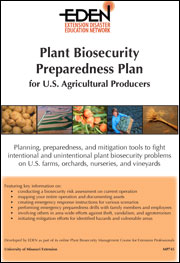Editor's note
The following abstract describes a publication that is only available as a downloadable PDF.
Warnings from government agencies and public interest groups point out that the agricultural sector is at high risk of terrorist activity and specifically, that the U.S. food supply is vulnerable to the intentional introduction of pests, diseases, and abiotic (nonliving) disorders, including damage caused by fertilizers and chemicals.
Therefore, it is incumbent upon those in the agricultural sector to join national homeland security efforts by instituting comprehensive preparedness activities so that producers, family members, employees, and agricultural consultants know how to respond appropriately to a suspected biosecurity problem. However, agroterrorism is not the only threat to U.S. agricultural producers. Theft, vandalism, and natural disasters (e.g., tornadoes, floods, and fires) also create emergency situations for producers. For this reason, the underlying philosophy of this guide is that preparedness practices in plant biosecurity management will also facilitate rapid and appropriate responses to any emergency situation.
This guide will provide you with tools to:
- Assess risks on your farm, nursery, orchard, or vineyard;
- Map your entire operation and document your assets;
- Prepare for a response to a potential plant biosecurity problem or other emergency; and
- Identify activities to help mitigate your vulnerability to theft, vandalism, or a biosecurity event, whether intentional or unintentional.
12 steps to preparedness planning
Individuals involved in the agricultural sector must have the knowledge and skills to respond to emergencies in a timely and efficient manner. Preparedness is the key to knowing how to react calmly and appropriately to an emergency situation, avoiding lost time and costly mistakes. This guide describes twelve emergency management steps to help improve the preparedness of individuals living and working on your premises:
- Post emergency response phone numbers and contact list
- Complete a risk assessment checklist
- Create maps and records of your operation
- Enhance your crop scouting and pest management skills
- Post visible address numbers and safety signage
- Sponsor an emergency responders' tour of operation and training event
- Meet with your insurance agent
- Conduct emergency response drills with employees, neighbors, frequent visitors, and family members
- Evaluate, revise and update your preparedness plan
- Involve others in preparedness planning
- Use your risk assessment checklist to identify mitigation activities
- Assemble your plan in a notebook for emergency responders
Topics
- Monitoring premises for potential plant and livestock biosecurity problems
- Procedures for suspected plant and livestock biosecurity problems
- Monitoring premises for theft, vandalism, and suspicious activity
- Procedures for suspected theft, vandalism, and suspicious activity
- Location of emergency phone numbers, contact lists, and MSDS copies
- Giving accurate directions to emergency responders
- Procedures for alerting others on the premises to an emergency situation
- Congregation points and accounting for everyone
- Procedures for evacuating the public from premises
- No "heroics"; avoid taking risks; wait for trained emergency personnel
- Proper use of respirators and other protective equipment
- Emergency wash station(s) and first aid station(s)
- CPR training
- First aid and decontamination training
Pages
- 36
